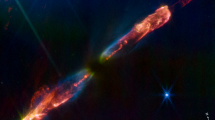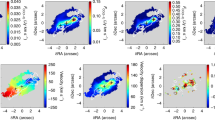Abstract
IMAGES of young stars1 and supernova remnants2 often reveal small, high-density knots of material which are interpreted as 'bullets' ejected by the source and propagating at supersonic speeds into the surrounding interstellar medium. But it is unclear how these bullets could be created and accelerated without disrupting their structure. An alternative interpretation of these features is that they condense in situ in high-velocity stellar winds as a result of hydrodynamical instabilities—such mechanisms have been proposed to explain the condensations seen in supernova ejecta3, and may also operate in planetary nebulae. Here we show that similar processes can also form bullets in the poorly collimated winds from young stars. We therefore suggest that bullets associated with outflow sources should not, in general, be ascribed to explosive events at the source; rather, they form as a direct result of the interaction between the outflowing gas and the surrounding medium.
This is a preview of subscription content, access via your institution
Access options
Subscribe to this journal
Receive 51 print issues and online access
$199.00 per year
only $3.90 per issue
Buy this article
- Purchase on Springer Link
- Instant access to full article PDF
Prices may be subject to local taxes which are calculated during checkout
Similar content being viewed by others
References
Allen, D. A. & Burton, M. G. Nature 363, 54–56 (1993).
Strom, R., Johnston, H. M., Verbundt, F. & Aschenback, B. Nature 373, 590–592 (1995).
Hester, J. J. et al. Astrophys. J. (in the press).
Bachiller, R. & Gomez-Gonzales, J. Astr. Astrophys. Rev. 3, 257–287 (1992).
Edwards, S., Ray, T. & Mundt, R. in Protostars and Planets III (ed. Levy, E. & Lunine, J.) 567–602 (Univ. Arizona Press, Tuscon, 1994).
Norman, C. & Silk, J. Astrophys. J. 228, 197–205 (1979).
Stone, J. M. & Norman, M. L. Astrophys. J. 420, 237–246 (1994).
de Gouveai Dal Pino, E. & Benz, W. Astrophys. J. 410, 686–695 (1993).
Riepurth, B. Nature 340, 42–45 (1989).
Stone, J. M. & Norman, M. L. Astrophys. J. 413, 210–220 (1993).
Raga, A. C. Rev. Mex. Astr. Astrofys. serie de conferencias 1, 103–117 (1995).
Scoville, N., Kleinmann, S. G., Hall, D. N. B. & Ridgway, S. T. Astrophys. J. 275, 201–224 (1983).
Genzel, R. & Stutzki, J. A. Rev. Astr. Astrophys. 27, 41–85 (1989).
Bunn, J. C., Hoare, M. G. & Drew, J. E. Mon. Not. R. astr. Soc. 272, 346–354 (1995).
Martì, J., Rodriguez, L. F. & Riepurth, B. Astrophys. J. 449, 184–187 (1995).
Spitzer, L. Jr. Physical Processes in the Interstellar Medium (Wiley-lnterscience, New York, 1978).
Castor, J., McCray, R. & Weaver, R. Astrophys. J. 200, L107–L110 (1975).
Weaver, R., McCray, R., Castor, J., Shapiro, P. & Moore, R. Astrophys. J. 218, 377–395 (1977).
Koo, B. C. & McKee, C. Astrophys. J. 388, 93–102 (1992).
MacLow, M.-M., McCray, R. & Norman, M. Astrophys. J. 337, 141–154 (1989).
Tomisaka, K. & Ikeuchi, S. Astrophys. J. 330, 695–717 (1988).
Gaetz, T., Edgar, R. J. & Chevalier, R. A. Astrophys. J. 329, 927–942 (1988).
Howarth, I. & Prinja, R. K. Astrophys. J. Suppl. 69, 527–592 (1989).
MacLow, M.-M. & Norman, M. L. Astrophys. J. 407, 207–218 (1993).
Garciia-Segura, G., MacLow, M.-M. & Langer, N. Astr. Astrophys. (in the press).
Tedds, J. A., Brand, P. W. J. L., Burton, M. G., Chrysostomou, A. & Fernandes, A. J. L. in Cloud Cores and Low Mass Stars (Clemens, D. P. & Barvainis, R.) 375–379 (Astr. Soc. Pacific Conf. Series, 65, San Francisco, 1995).
Staude, H. J. & Elsasser, H. Astr. Astrophys. Rev. 5, 165–238 (1993).
Schwartz, R. D. et al. Astr. J. 106, 740–746 (1993).
Gull, S. F. Mon. Not. R. astr. Soc. 161, 47–69 (1973).
Chevalier, R. A. & Klein, R. Astrophys. J. 219, 994–1007 (1977).
Herant, M. & Benz, W. Astrophys. J. 370, L81–L84 (1991).
Harrington, P. Bull. Am. astr. Soc. 26, 1469 (1995).
Author information
Authors and Affiliations
Rights and permissions
About this article
Cite this article
Stone, J., Xu, J. & Mundy, L. Formation of 'bullets' by hydrodynamical instabilities in stellar outflows. Nature 377, 315–317 (1995). https://doi.org/10.1038/377315a0
Received:
Accepted:
Issue Date:
DOI: https://doi.org/10.1038/377315a0
This article is cited by
-
Filaments in creation's heart
Nature (1996)
-
Heated gaseous streamers and star formation in the Orion molecular cloud
Nature (1996)
-
Bullets or fragmenting shells?
Nature (1995)
Comments
By submitting a comment you agree to abide by our Terms and Community Guidelines. If you find something abusive or that does not comply with our terms or guidelines please flag it as inappropriate.



